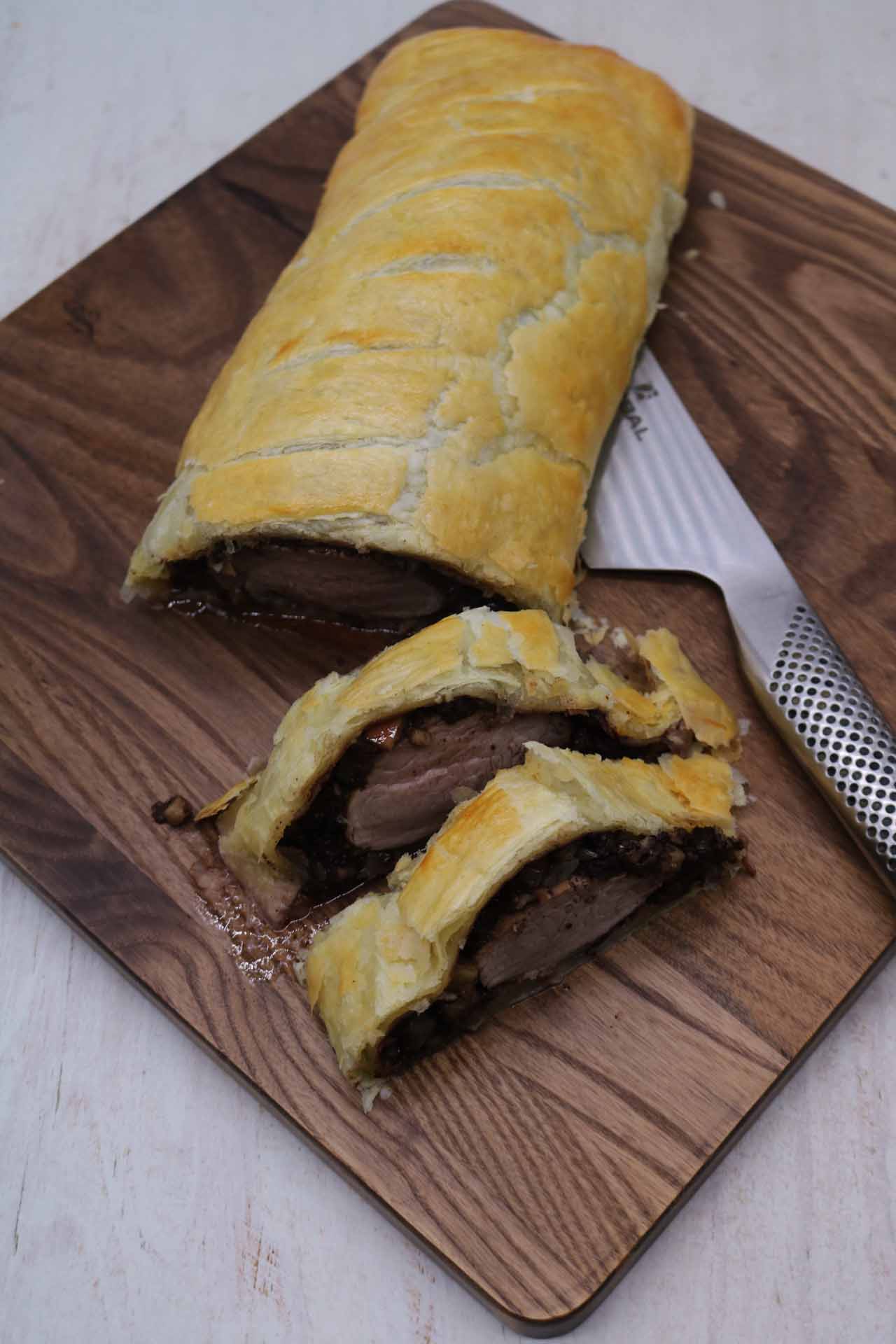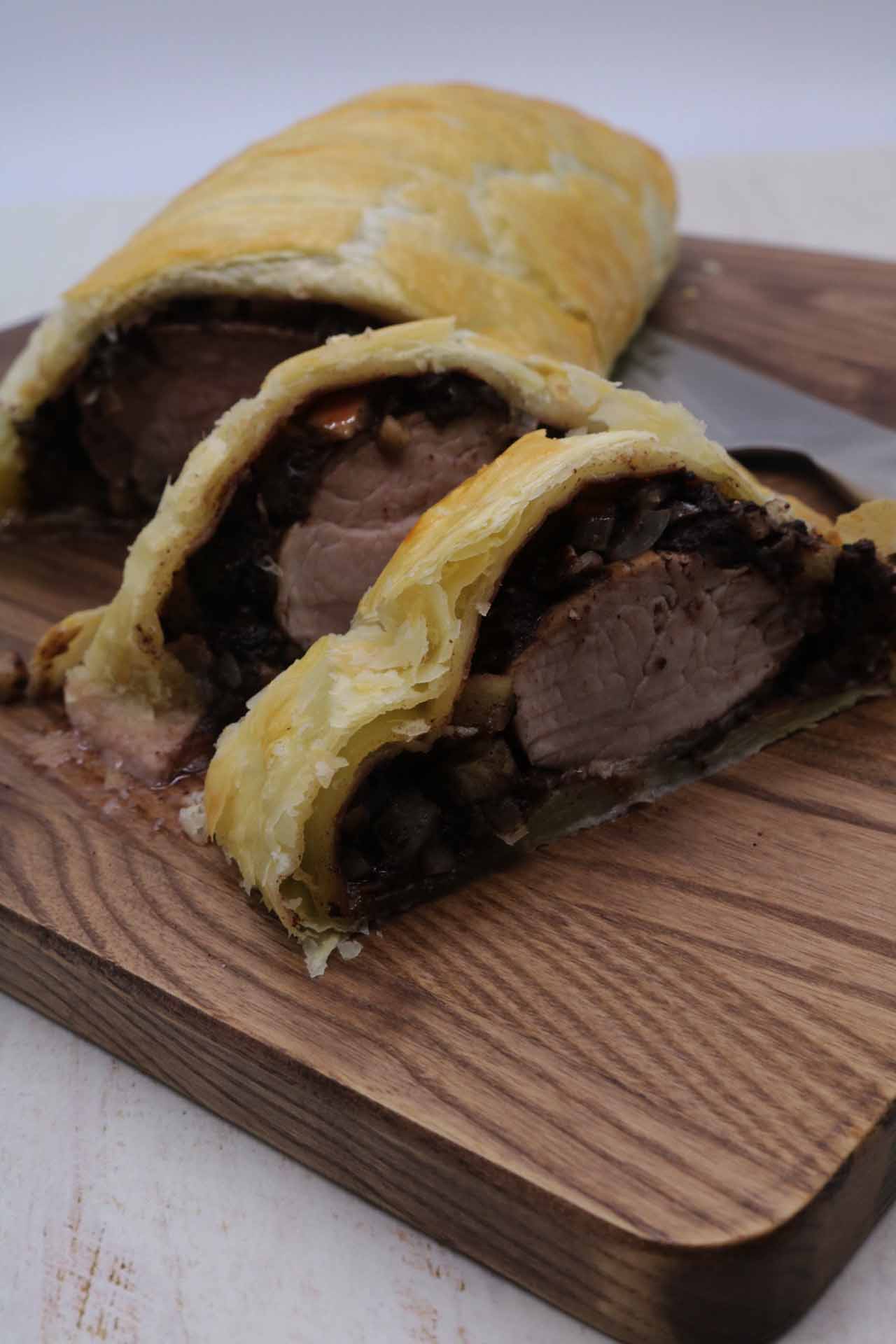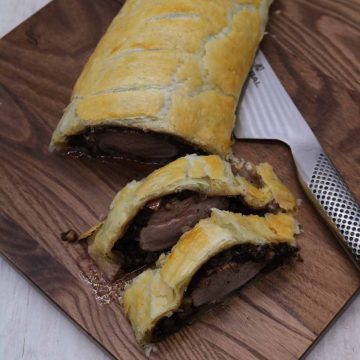
This pork wellington with black pudding recipe is from The Hairy Bikers' Meat Feasts recipe book.
We both love beef wellington and have never had pork wellington before, so this is the first time we've made it and eaten it!
There is a bit of prep to make the black pudding mixture, but once that's done and the pork fillet has been browned, the assembly is pretty straight forward and then the oven does the rest of the work!
The end result is beautifully tender pork fillet encased in a delicious black pudding and apple mixture and crisp puff pastry...yum! This pork wellington with black pudding is a delicious dish to make at the weekend and if you have guests for dinner.
Tip
- Pastry - I bought 2 x 375g packs of ready rolled puff pastry thinking I was going to use a bit from the second pack. However, the length of one sheet was already 38cm, so I decided just to roll out the width a bit to make it 28cm. This was big enough for a pork fillet weighing 600g. It just meant I didn't have any offcuts of pastry for decorating the wellington, so I used a sharp knife to make light diagonal cuts about an inch apart along the length instead. The second pack of pastry can be used for something else!
Other Recipes
You might also like to try:
Recent New Recipes

Ingredients
- 1 tbsp butter
- 1 onion, finely chopped
- 50ml Calvados
- 1 small eating apple, finely diced
- 1 tsp rubbed sage (or 0.5 tsp ground sage)
- 150g black pudding, crumbled
- salt and freshly ground black pepper
- 1 tbsp olive oil
- 1 pork tenderloin (fillet) (500 to 700g)
- plain flour, for dusting work surface
- 500g ready-made/rolled puff pastry (see Tip)
- 6 slices prosciutto (Italian ham)
- 1 egg, beaten
Instructions
- Melt the butter in a non-stick frying pan over a medium heat. Add the onion and fry it for 3 to 5 minutes until it’s soft and translucent. Turn the heat right up, then add the Calvados and let it bubble away until it has almost completely evaporated (about 1 minute). Remove the pan from the heat and leave the onion to cool.
- Put the cooled onion in a bowl with the apple, sage and black pudding. Season with salt and freshly ground black pepper and mix everything together well.
- Heat the olive oil in the frying pan over a medium to high heat, add the pork and fry it, turning regularly (approx. every 45 seconds) until the meat is sealed and well browned on all sides. Remove it from the heat. Preheat the oven to 200C/180C fan/gas 6.
To assemble and cook the wellington:
- Dust a work surface with flour and roll out the puff pastry into a rectangle slightly longer than the pork and wide enough to completely encase it (at least 30cm x 40cm).
- Lay the slices of prosciutto over the pastry, making sure you leave a pastry border of at least 1cm all round them. Spread the black pudding mixture over the prosciutto. Pat the seared pork dry with kitchen roll, then place it along the centre of the covered pastry.
- Brush the edges of the pastry with beaten egg, then wrap the pastry around the pork to form a large sausage shape. Press the ends of the pastry together to make sure the parcel is completely sealed and tuck them underneath. Place the Wellington on a non-stick baking tray, making sure it is seam side down.
- Decorate the top with offcuts of pastry if you like, then brush the whole thing with more beaten egg.
- Bake the parcel in the preheated oven for 20 minutes, then turn the temperature down to 180C/160C fan/gas 4 and cook for another 15 to 20 minutes, until the pastry is golden brown. Remove the Wellington from the oven and leave it to rest for at least 10 minutes. Cut into slices and serve with your choice of side dishes.
Did you make this recipe?
I’d love to hear how it went…both good and bad!
Please go to the bottom of the page to rate the recipe and/or leave your comments.
It would also be great if you could take a photo and tag Felly Bull on social media, thanks.
Subscribe to receive our new and highlighted recipes in your email inbox each week...plus receive our new e-Cookbook for free!!!

Pork Wellington with Black Pudding
Ingredients
- 1 tbsp butter
- 1 onion finely chopped
- 50ml Calvados
- 1 small eating apple finely diced
- 1 tsp rubbed sage (or 0.5 tsp ground sage)
- 150g black pudding crumbled
- salt and freshly ground black pepper
- 1 tbsp olive oil
- 1 pork tenderloin fillet (500 to 700g)
- plain flour for dusting work surface
- 500g ready-made/rolled puff pastry (see Notes)
- 6 slices prosciutto (Italian ham)
- 1 egg beaten
Instructions
- Melt the butter in a non-stick frying pan over a medium heat. Add the onion and fry it for 3 to 5 minutes until it’s soft and translucent. Turn the heat right up, then add the Calvados and let it bubble away until it has almost completely evaporated (about 1 minute). Remove the pan from the heat and leave the onion to cool.
- Put the cooled onion in a bowl with the apple, sage and black pudding. Season with salt and freshly ground black pepper and mix everything together well.
- Heat the olive oil in the frying pan over a medium to high heat, add the pork and fry it, turning regularly (approx. every 45 seconds) until the meat is sealed and well browned on all sides. Remove it from the heat. Preheat the oven to 200C/180C fan/gas 6.
To assemble and cook the wellington:
- Dust a work surface with flour and roll out the puff pastry into a rectangle slightly longer than the pork and wide enough to completely encase it (at least 30cm x 40cm).
- Lay the slices of prosciutto over the pastry, making sure you leave a pastry border of at least 1cm all round them. Spread the black pudding mixture over the prosciutto. Pat the seared pork dry with kitchen roll, then place it along the centre of the covered pastry.
- Brush the edges of the pastry with beaten egg, then wrap the pastry around the pork to form a large sausage shape. Press the ends of the pastry together to make sure the parcel is completely sealed and tuck them underneath. Place the Wellington on a non-stick baking tray, making sure it is seam side down.
- Decorate the top with offcuts of pastry if you like, then brush the whole thing with more beaten egg.
- Bake the parcel in the preheated oven for 20 minutes, then turn the temperature down to 180C/160C fan/gas 4 and cook for another 15 to 20 minutes, until the pastry is golden brown. Remove the Wellington from the oven and leave it to rest for at least 10 minutes. Cut into slices and serve with your choice of side dishes.
Notes
- Pastry - I bought 2 x 375g packs of ready rolled puff pastry thinking I was going to use a bit from the second pack. However, the length of one sheet was already 38cm, so I decided just to roll out the width a bit to make it 28cm. This was big enough for a pork fillet weighing 600g. It just meant I didn't have any offcuts of pastry for decorating the wellington, so I used a sharp knife to make light diagonal cuts about an inch apart along the length instead. The second pack of pastry can be used for something else!









LEAVE A COMMENT AND RATE THIS RECIPE